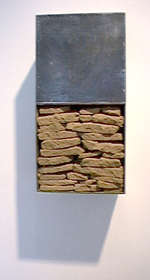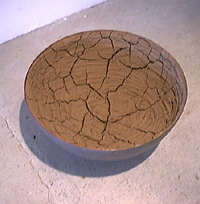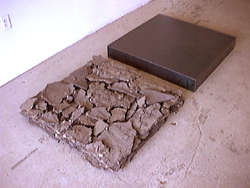Madeleine Dietz
| Aesthetic dis-union as the answer to realistic violence - two interpretations of Madeleine Dietz's work. |
||||||||||
|
Madeleine Dietz's artistic view point shows an aesthetic dualism: Systematically she mediates the sensory experience of two conditions that are not prepared to fuse in unity. She composes, or better, she constructs objects in juxtaposition to artistic creations, so thet contradicting priciples are found in tension-filled harmony without loosing their identity. The choice of materials and creation of form allows for contradictory interpretation: The clods of earth dried in the air and the rusty iron plates can be seen as pure artistic or sculptural material. Erected to a simple, visually controllable, exact construction, which means nothing more than the observing himself. This "absolute clarity" has the same significance as Theo van Doesburg's concrete art. The aim of this direction is "to create objects for mental use" (Max Bill)-to allow ideas-in this case in space-to become visible. The initial materials used can be taken in the meantime from various spiritual and physical areas. "Using anti geometrical, amorphous elemants, concrete art can take its form equally from the geometrical or the mathematical way of thinking" (Max Bill). In this respect, Medeleine Dietz creates sculptural installations and sedimentation where the effect of polar forces can be experienced. |
||||||||||
| By making full use of contrasts, the artist organise a meeting of earth and steel, whose material qualities, such as brittleness or firmness increase their mutual sensory perception. The layers, exactly constructed to maintain the form, create a permeable surface structure on an otherwise hermetic geometric body. Density and voidness, inside and out, appear as empty form and shape values. In spite of the amassing of the clods, the massivness of the iron cannot be reached. Both materials vary in the manifestation of area and volume, above all, the area dynamically influences its surroundings. The action of the origination remains visible, and besides the expansion she brings the aspect of time in the observation of the work, simultaneously she causes the reception to be a process of recognition. | ||||||||||
 |
||||||||||
| Yet, on the basis of the dualistic starting point and because of the denial of the absolute, these works can also be interpreted as "refering" art. The qualities of the clods of earth and of the steel stand as synonyms for the human characters and reactions: Labile sensitivity leans on constant strength which gives cautions protection. Naturally, Madeleine Dietz presents the female and the male principles, but it is left to the observer to decide to which recipient he assigns the active, the creative or the passive. "Spiritus" and "Anima" do not unite here in the "Hochzeit" (Augustinius), mind and soul retain their independence and move into an imancipated relationship. | ||||||||||
|
Two Cubes on the Wall Soil,
Steel |
||||||||||
 |
||||||||||
| That, which is found in natural surroundings, hardly treated manually, meets the mechanically manufactured - although not in destructive conflict, the artistic intervention provokes an aestetic-harmonic tension. Without formulating, the nature-technology problem is quoted. Destruction, disorder and chaos as a possible state of being are suspected and sometimes also visible. The prehistoric appears to unite with the present to form the future. Associatively one can discover the traces of nature and mean that are protected, hidden or recorded for all times in steel enclosures. One thinks, one has encountered rudimentary archaic architecture, dynamic wall remnants, or one believes that one has entered a magic place. Particularly by the horizontally alined rectangular works, one gets the impression of, for example, a ritualistic site or a cemetary. The dustiness of the clods of earth together with the rust of the steel make the sculptures symbols of vainness. | ||||||||||
|
Half Ball Soil,
Steel |
||||||||||
| The eternal passage of time is sensed, but is not painfully present, there is always a reference to new origination, either visible as soft but steady forces of the "fertile earth" that seems to move the convering metal plates or is suspected underneath or inside the steel structures. The calculated collision of contrasts releases streams of creative energy. Because of the materials and their arrangement a continuous concealing and appearing is demonstrated, a reference to the invisible, which gives the work a transcendental dimension. However, the "here after" is not played off against the present and the spirit remains united with the matter. The observer's standpoint is not clearly defined in the work itself, being composed to be viewed from various angles, according to one's own philsosphy and by walking through and around the works one establishes a personal vantage point. | ||||||||||
 |
||||||||||
| Madeleine Dietz supports ambiguity, she is not concerned with overcoming dualism. Although her work shows the incompatible in aesthetic tension, it does not abolish the dialectic in the sense of synthesis. The individual and collective experiences of physical and psychological violence with which the artist is confronted at the end of the 20th century silenced her need to harmonize. She refuses herself conciliatory gestures, pacifying egalitarianism; her aim is directed at the effectual power of fertile conflicts between two contrasts, to relate with and endure these - that is her answer to uncontrolled aggression. | ||||||||||
|
Square
on the Floor Soil,
Steel |
||||||||||
| Hans Gunter Golinski | ||||||||||
and the United States sponsored by Gallery Roesch, Germany.
| Events | Archives | Madeleine Dietz |
|
All work © copyright of the artist. Originally posted on 7/4/98; 7:41:26 PM, updated on 6/4/99; 6:00:11 PM Please contact the webmaster if you have website questions or problems. |